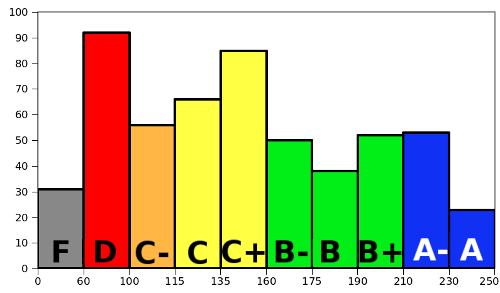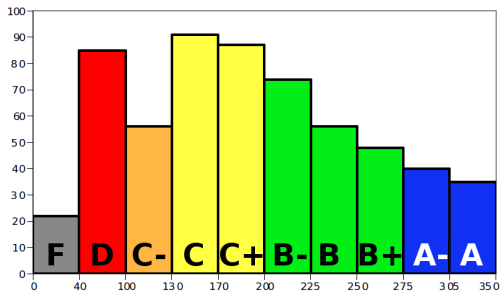First Midterm: 8:30 pm on Wednesday, February 24, 2010
Bring a photo ID. No calculators will be allowed. Bring a pen to the exam: while you may do the midterm in pencil (or crayon), you can only contest grading of problems done in non-erasable ink. Sorry. The midterm covers sections 5.1 through 5.4 of the text.Doing all of the homework problems prior to the exam is a very good idea. Doing additional problems from the text can be helpful.
It is important that you know the basic collection of integrals (which correspond to the derivatives of the standard functions). Such a table appears on page 358 of your text (or here).
You should be able to do all the problems on these practice exams from previous semesters. Of course, ability to do all of these is not a guarantee of success on the midterm; the actual exam will cover similar material, not identical problems.
- Midterm, Spring 2000 (solutions typo on 4a fixed 2/21, typo on 2 fixed 2/22)
- Practice, Spring 2006 (solutions)
- Midterm, Fall 2007 (solutions minor fix to #6 2/23)
Results: If you received a grade of less than 100 on this midterm, you are in danger of needing to retake the course. If you expect to get a grade of C or higher, you will need to change how you approach this class.
Below is a graph of the score distribution on the exam.

|
|
You can check your grade here.
There were three different versions of the exam. They are the monkey version (Solutions), the lemur verion (Solutions), and the emu version (Solutions). Collect 'em all!
Second Midterm: 8:30 pm on Thursday, March 25, 2010
The second midterm will cover the material we have covered since the first
exam: sections 5.5, 5.6, 5.7 and 5.9. (We didn't do 5.8, and 5.10 is not
on the midterm; it is covered on the homework and will be on the final.)
PLEASE BRING A PEN, as well as a photo ID.
You should be able to do all the problems on these practice exams from previous semesters. Of course, ability to do all of these is not a guarantee of success on the midterm; the actual exam will cover similar material, not identical problems.
- Midterm, Spring 2000 (solutions some typos fixed 2/24)
- Practice, Spring 2007 (doesn't cover 5.7 or 5.9, but includes 5.4) (solutions)
- Practice, Fall 2009 (includes 5.4) (solutions)
- 5 very easy integrals.
- 6 integrals where we suggest the method to use.
- 3 indefinite integrals where you figure out the method to use.
- 3 definite integrals (you figure out the method)
- Use Simpson's, Midpoint, or Trapezoid rule to approximate an integral, and, in another part, tell how big n should be to ensure a certain level of accuracy.
Results: A lot of people did quite well on this exam, but many
did very, very poorly. Two people had no points taken off.
Below is a graph of the score distribution on the exam.

|
|
You can check your grade here. If you got a C- or lower on the exam, you will need to make some significant changes if you expect to pass the course, even if you are getting an A on homework.
You can get a copy of the exam, as well as the solutions. Only a limited number of these valuable collector's editions will be printed, so they are sure to increase in value. They are available in three versions: the electric version (solutions), the acoustic version (solutions), and the instrumental version (solutions). Order now! Operators are standing by.
Final Exam: 8:30pm on Monday, May 17, 2010
The final will be cumulative, covering everything that we have done in the class. However, extra emphasis will be on material since the second midterm. There will be 10 questions, with 5 of them coming from material since the previous midterm, and 5 questions on material covered by the first two midterms.
All sections of Mat126 will have the final in the Sports Arena. Please bring a Photo ID.
It is much more important that you understand how to do calculus than memorize a bunch of formulae. So, I will let you bring a single sheet of notes with you to the exam. This note sheet must be handwritten, not a xerox or a printout. It can be written only on one side of the page, the page can be no larger than a standard sheet of letter paper (8.5" by 11"), and the sheet must be turned in along with your exam. Students using notes which don't fit this guideline will be charged with academic dishonesty. Note that you can write whatever you think will be helpful on your notes: formulae, examples, or the lyrics to your favorite song.
In order to study, you should do lots of problems. While doing the Extra Credit assignment on WebAssign will help, it isn't sufficient unless you are already well-prepared. Some material that will be on the final (polar coordinates, complex numbers, etc.) is not covered on the extra credit assignment. Remember that you can also get the solutions to all the old online homeworks in WebAssign.
In addition, here are some practice problems from previous years. Note that neither of these include polar coordinates or complex numbers (ours will).
Please work the problems before reading the solutions, or they won't do you any good.
Results: The final had a few difficult problems, but also some easy
ones. As usual, some people did well, others did terribly.
Below is a graph of the score distribution on the exam.

|
|
You can check your grade here.